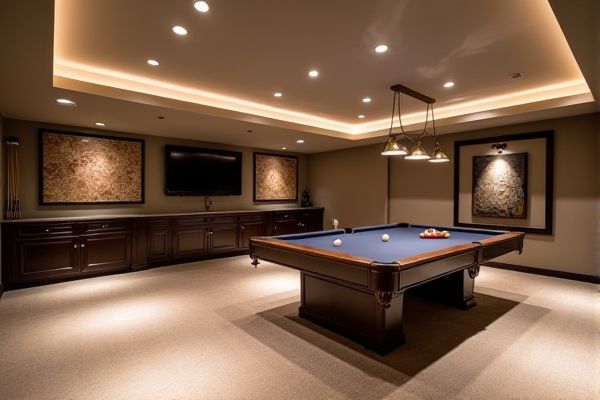
Choosing between a billiard table and a ping pong table for your basement depends on available space, activity preference, and storage options since billiard tables require more room and a specific setup. Explore the rest of this article to discover which table best suits your basement and lifestyle needs.
Table of Comparison
| Feature | Billiard Table | Ping Pong Table |
|---|---|---|
| Dimensions | 9 ft x 4.5 ft (Standard) | 9 ft x 5 ft (Standard) |
| Space Required | At least 13 ft x 17 ft for comfortable play | At least 14 ft x 7 ft recommended |
| Ceiling Height | Minimum 8 ft | Minimum 8 ft |
| Flooring | Flat, level surface for stable installation | Flat, non-slippery surface preferred |
| Lighting | Bright, focused overhead lighting to reduce shadows | Even, diffused lighting recommended |
| Noise Level | Moderate due to cue strikes | Higher noise from fast ball impacts |
| Storage | Requires space for cues and balls | Requires rack for paddles and balls |
| Use in Basement | Ideal if ample space and humidity control available | Suitable for moderate space; humidity less critical |
Billiard Table vs Ping Pong Table: Which Suits Your Basement Best?
A billiard table requires more stable, level flooring and generally takes up more space, making it ideal for larger basements with consistent humidity control to protect the slate surface. Ping pong tables are more versatile, often foldable, and better suited for smaller or multi-purpose basements due to their portability and lower installation requirements. Consider ceiling height as ping pong demands ample clearance for high shots, whereas billiard tables need sufficient surrounding space for cue maneuvering.
Space Requirements: Billiard Table vs Ping Pong Table
Billiard tables typically require a minimum space of 13 by 16 feet to comfortably accommodate player movement and cue swings, while ping pong tables need about 10 by 20 feet for competitive play. The compact design of some ping pong tables with foldable features can make them more adaptable in basement settings where space is limited. Consider ceiling height for billiard tables, as ample overhead clearance is essential, whereas ping pong tables generally demand less vertical space.
Cost Comparison: Billiard Table vs Ping Pong Table
Billiard tables typically range from $1,000 to $3,000 depending on size and materials, while ping pong tables cost between $200 and $1,200, making them a more budget-friendly basement option. Installation and space requirements for billiard tables can add to overall costs, often requiring professional setup, whereas ping pong tables are easier to assemble and sometimes foldable for storage. Maintenance expenses for billiard tables, such as felt replacement and slate leveling, generally exceed those for ping pong tables, which primarily require occasional surface cleaning.
Gameplay Experience: Billiards vs Ping Pong in the Basement
Billiard tables in the basement offer a slower-paced, strategic gameplay experience that emphasizes precision and focus, ideal for intimate gatherings and relaxed competition. Ping pong tables provide fast-paced, energetic play that requires quick reflexes and ample space for movement, making your basement feel more dynamic and active. Choosing between them depends on your preferred level of physical activity and space availability for an optimal gaming environment.
Installation and Maintenance: What to Expect
Installing a billiard table in a basement demands precise leveling and sufficient space for cues, while a ping pong table requires minimal assembly and can be folded for storage. Maintenance of a billiard table involves regular felt cleaning and occasional cushion replacement, whereas ping pong tables need surface cleaning and hinge lubrication for smooth folding. Both require humidity control in the basement to prevent warping and ensure optimal play conditions.
Social Interaction: Hosting Friends and Family
A billiard table in the basement fosters relaxed, strategic gameplay that encourages conversation and friendly competition among adults, making it ideal for intimate social gatherings. A ping pong table injects energy and fast-paced fun, engaging players of all ages and promoting active interaction during family events. Both setups enhance social interaction, with billiards offering a classic, leisurely vibe and ping pong providing dynamic, inclusive entertainment.
Design and Aesthetic Considerations
Billiard tables typically feature rich wood finishes, leather pockets, and felt surfaces, creating a classic, elegant aesthetic that can serve as a focal point in a basement. Ping pong tables offer a more modern and minimalistic design, often made with lightweight materials and foldable features that suit versatile basement layouts. Choosing between them depends on desired ambiance, with billiard tables emphasizing tradition and style, while ping pong tables prioritize functionality and space efficiency.
Multi-Functionality and Alternative Uses
A billiard table in a basement offers multi-functionality by often converting into a dining or card table, maximizing space efficiency for various activities beyond gaming. Ping pong tables provide versatile entertainment options as they can be folded and stored easily, freeing up room when not in use for other basement purposes like workouts or social gatherings. Your choice depends on whether you prioritize a permanent, stylish centerpiece or a flexible, storable game station.
Noise Levels and Neighbor Considerations
Billiard tables produce minimal noise, mostly from balls clacking quietly, making them suitable for basements without disturbing neighbors. Ping pong tables generate louder, rapid ball impacts and player movements, potentially causing noise complaints in shared or multi-level buildings. Your choice should prioritize how noise travels in your basement and the sensitivity of neighbors to avoid conflicts.
Making the Right Choice for Your Basement Fun Zone
Choosing between a billiard table and a ping pong table for your basement fun zone depends on available space and intended entertainment style. A billiard table requires more floor space and offers a classic, social gaming experience, while a ping pong table is ideal for active, fast-paced play and can often be folded to save room. Consider ceiling height, lighting, and player preferences to optimize your basement for maximum enjoyment and functionality.
 homyna.com
homyna.com